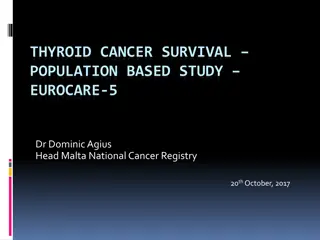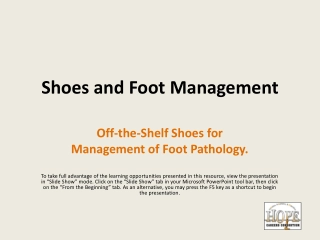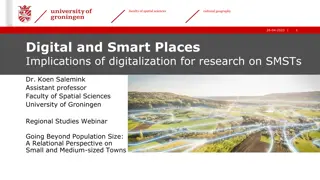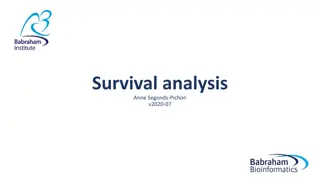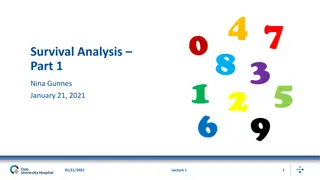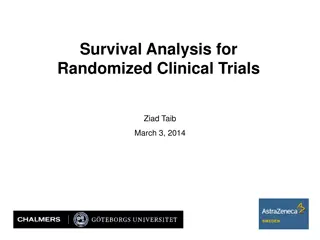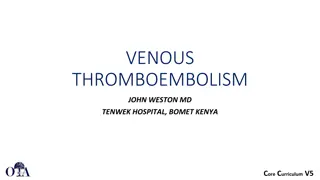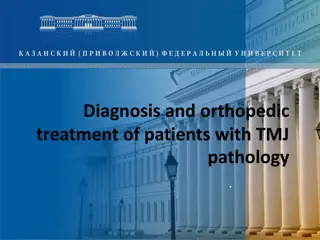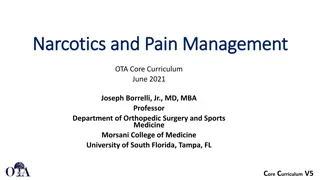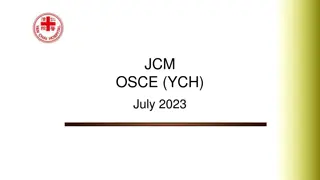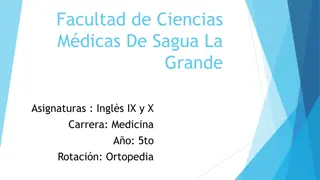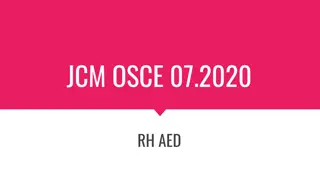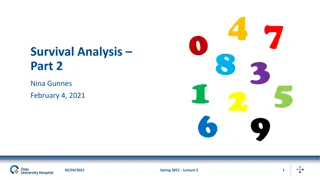Survival Strategies for Medium-Sized Orthopedic Group Practices
Understanding the challenges faced by medium-sized orthopedic group practices and implementing strategies such as high-quality specialized care, leveraging mid-level providers, and diversifying revenue streams are key to survival in the changing healthcare landscape.
- Orthopedic practices
- Revenue diversification
- Healthcare strategies
- Mid-level providers
- Survival tactics
Download Presentation

Please find below an Image/Link to download the presentation.
The content on the website is provided AS IS for your information and personal use only. It may not be sold, licensed, or shared on other websites without obtaining consent from the author. Download presentation by click this link. If you encounter any issues during the download, it is possible that the publisher has removed the file from their server.
E N D
Presentation Transcript
Medium Sized Group Practice Survival in the New Age JOHN R. CORSETTI, MD MANAGING PARTNER NEW ENGLAND ORTHOPEDIC SURGEONS SPRINGFIELD, MA
I have no disclosures to report.
New England Orthopedic Surgeons Structure Governance Ancillaries/Diversified Revenue Streams Hospital Cooperation v. Competition The Future for Private Practice Orthopedic Surgery .
NEOS Snapshot 16 surgeons, 30 mid-levels, 200 employees, Springfield, MA 1 practice location (50,000sqft) currently, second location (7000sqft) opening Spring 2017 Single hospital affiliation 3 Surgical venues Inpatient (TJR, spine, trauma) Outpatient hospital based multispecialty surgery center Outpatient free standing hospital owned surgery center
NEOS Snapshot Surgeon Profile: 3 Sports 3 TJR 3 Hand 1 Spine 4 Trauma 2 Foot and Ankle MISSING: reconstructive pediatric ortho and tumor. Serve as Ortho Dept for large tertiary care hospital ..no other ortho docs on staff
Principles of Viability High quality subspecialized care, including trauma Segregation of all call/consult duties amongst 4 dedicated traumatologists Extensive use of mid-levels (leverage) Survival dependent on volume and efficiencies Collection ratio 28% in Western Mass! Partner rather than compete with Hospital Comanagement, Trauma, ASC Use ancillaries and midlevel revenue to hedge against reimbursement declines (Income Diversification)
The Harsh Realities.. Gradual shift of patients to lower reimbursing payors Ratcheting down of reimbursement per work unit Currently collecting 28% of charges Expenses continue to rise Yet we have still maintained surgeon income above 90% MGMA
Key Practice Drivers High quality care is paramount, and never compromised Increase volume with funnel model ..mid-levels manage much of the nonoperative orthopedic care Leveraging midlevels critical to our model (more on this .) Ancillary revenue scaled up as practice volume increases DME Medical legal Co-management contracts Physical Therapy Urgent Care in the works
Governance Executive Director (paid at 90% MGMA guidelines) 3 physician Executive Committee, meets weekly, minutes distributed Any physician welcome to attend executive committee meetings Quarterly board meetings All significant decisions unanimous or near unanimous All decisions with >$5K impact need board approval Disagreements generate discussion until unanimity is reached. Goal is to function as a true partnership (vs. doctors sharing overhead)
Governance Executive committee sets agenda for quarterly Board Meeting No stipend for leadership positions in group currently Off hour meetings to avoid cutting into clinical productivity Elected positions, 2 year term, but some internal consistency exists Physicians have prominent roles in PHO and in hospital administration
Use of Mid Levels Funnel model, use to increase practice access Highly trained before seeing patients independently (6 mos) Facilitate surgery out of 2 rooms Paid at 90% MGMA: 60% fixed salary, 40% bonus based on practice profitability and individual metrics Paid X, collect 3-5X. Highly profitable, not including increased efficiency of surgical practice
Mid Levels Practice manages schedules of PAs Set template based on PA skill, complexity of patient population Open time vs. Physician Specific Blocks , used for pre and post ops, new patient intake, test review. Salaries AND revenue treated as practice expense and revenue rather than allocated to specific physician Mid-levels generate substantial revenue to the practice, as well as increasing efficiencies for MD s in office and OR.
Mid Levels.Secret Sauce Use of mid levels allows shift in OR/office ratio for surgeons, without sacrificing the office revenue Predicated on Highly skilled, trained, specialized mid levels Patient acceptance of model Fee for service payment model
Hospital Relations: Cooperate v. Compete Trauma Co-Management: Floor and ER PA coverage, Co-Management agreement ASC Co-Management: hourly rate plus metric based, dedicated anesthesia, ortho only ASC TJR Co-Management: Co-management agreement currently being crafted.
Ancillaries Given inevitable declines in reimbursement, group has hedged with ancillaries Physical Therapy, Co-Management Agreements, DME, Extenders, Medical Legal. Considered others (MRI, Urgent Care Center). Because ancillary services are linked to practice volume, they scale up as practice grows. Ancillary revenue has grown from negligible to 40% of total income in the last 15 years.
Ancillaries: Things to Consider Revenue Division Stark and Anti kickback regs, need legal opinion generally Can t divide on a per click basis Buy in for new physicians (dollar amount v. delayed entry), generally 1-2x yearly profit/partner. Options: even split v. shares based on rough contribution Cash Flow Implications Treat as separate business Rigorous analysis of all start up costs and effect on monthly cash flow Best case/Likely case/Worst case scenario calculations
Ancillaries: Things to Consider Will the ancillary be profitable in YOUR MARKET? Example: ASC can be a major cash flow drain and is not profitable in all markets. Mistakes have long lasting implications and can destroy groups Consider: effect on hospital/therapy groups/MRI providers/local brace shop. Medical Community as Ecosystem: imbalance can lead to disruption and collapse of entire system.
Ancillaries...Our Approach ASC Demographic and specific payor issues made pro forma marginal Opted to partner with Hospital, crafted scalable comanagement agreement 60% based on hourly wage, 40% metric based No $ up front, no equipment/profitability concerns, no hosp competition Buy in is 2 years after partnership granted, so 4 years after commencing employment. 3rdparty revaluation every 2 years allows scaling (very important in long term agreement) Divide salary revenue by shares: 1 share for non ASC docs, 2 shares for ASC docs. Divide metric based revenue evenly amongst ASC docs only
AncillariesOur Approach DME Brace Shop with certified orthotists (rather than stock and bill ) Used major brace company, software integration into Intergy Split revenue equally Treat as independent cost center, with all expenses and revenue segregated from orthopedic practice for analysis.
AncillariesOur Approach Physical Therapy 2 Sites, planning more, but carefully considering effect on community therapy groups who refer patients. Revenue split evenly Buy in is 1 year beyond partnership (so 3 years total after commencing employment).
AncillariesTrauma CoManagement Rejected the usual pay for call option difficult precedent for hospital Calculated cost of taking call by comparing revenue of Ortho Trauma doc to average revenue of Elective Practice doc then multiplied by 4. Clinical Support: PA for floor coverage AND PA Ortho Associates cover ER
Hospital Relations Strategy: to construct classic win-win scenarios ASC, Trauma co management in place Urgent Care, Joint and Spine Co Management under construction Opted to forgo MRI ancillary would create competitive imbalance with hospital
Total Joint Bundle Involved in Medicare/private payor bundle for joint replacement Opportunity for cooperation with hospital, parlaying into Co- management agreement Success dependent on both parties heavily engaged and aligned in service line management (implants, discharge, pharmacy, etc)
The Future: Challenges and Threats Volume Threats: competitive hospital systems aligning with large medical groups to restrict patient flow Reimbursement Threats: how low can we go?! Legislative Threats: therapy, ASC, DME?? Internal Strife: Revenue distribution formula always an issue A fair formula today may not be fair tomorrow!! Need constant re-evaluation
Conclusions Like any business, stagnation leads to obsolescence and ultimately failure Need to be proactive and thoughtful (vs reactionary) Only Win-Win deals are durable What works in one demographic may not work in others Strategic errors can cripple a practice, look before you leap! Diversified and scalable revenue streams critical


